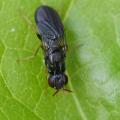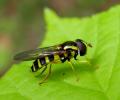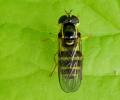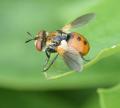|
Psychodidae
|
|
| Stephen |
Posted on 27-09-2006 21:31
|
|
Member Location: Posts: 1322 Joined: 12.04.05 |
For twenty years I have been seeing these flies regularly appear for a few days at my workplace (a small college) and then disappear again. They are most common in the bathroom, but sometimes are in the hallway too. I suspect they have a completely-indoors life cycle in this location. Only when I looked in my lens today did I realize they are Moth flies. Any hope of narrowing the ID further? Photographed today, West Virginia USA. Length, 4.6 mm, from front of eyes to the rear of a wing. --Stephen Stephen Cresswell www.americaninsects.net |
|
|
|
| Tony Irwin |
Posted on 27-09-2006 21:45
|
|
Member Location: Posts: 7168 Joined: 19.11.04 |
The common "drain fly" in Europe is Psychoda alternata, which I believe also occurs in much of the USA. I think this is probably what you have photographed
Tony ---------- Tony Irwin |
|
|
|
| Stephen |
Posted on 27-09-2006 22:48
|
|
Member Location: Posts: 1322 Joined: 12.04.05 |
Thanks, Tony. I couldn't find any good on-line images of the species, but I did find a website that said the species could be found just about anywhere in the United States (as well as in other areas of the world). Amazing to think the larva can make their homes in wash basin drains. I suppose they either cling to the sides or risk being washed away. Maybe some are washed away, since apparently they are also found at sewage plants? They've always seemed like clean, pleasant flies to me. I'm glad I know what they are now. Thanks, Tony. --Stephen Stephen Cresswell www.americaninsects.net |
|
|
|
| Tony Irwin |
Posted on 27-09-2006 23:23
|
|
Member Location: Posts: 7168 Joined: 19.11.04 |
The overflow section of the basin is often where they're found - sufficient nutrients are splashed up into that section to provide a good growth of bacteria and fungi on which the larvae feed, and there's less risk of being washed away, or scalded by hot water. As you say, they are an important element of the sewage plant fauna. I suspect they may play a role in the processing of the sewage in the filter beds, but they are generally disliked because they are a nusiance, and have been implicated in brochial asthma among sewage workers, as well as being a potential carrier of pathogenic organisms.  Pity - they're such cuddly-looking flies! Pity - they're such cuddly-looking flies!
Tony ---------- Tony Irwin |
|
|
|
| Stephen |
Posted on 27-09-2006 23:47
|
|
Member Location: Posts: 1322 Joined: 12.04.05 |
One more question here, and that is about length. I see some on-line sources say Psychoda alternata is about 2 mm in length. Not sure what the standard way to measure flies is? If I go from the front of the head to the rear of the abdomen on my fly, I get 3.3 mm. If I go from the front of the head to the rear of the left wing (this is somewhat diagonal) I get 4.6 mm. Of couse all this includes the "fur"! --Stephen Stephen Cresswell www.americaninsects.net |
|
|
|
| pierred |
Posted on 28-09-2006 06:24
|
|
Member Location: Posts: 1413 Joined: 21.04.05 |
Stephen, A wonderful pic!! This is the first time I see such a sharp picture of this fly. Pierre Duhem |
|
|
|
| Robert Nash |
Posted on 28-09-2006 17:16
|
|
Member Location: Posts: 288 Joined: 11.11.05 |
Public Health Significance See http://www.entomology.ucr.edu/ebeling/ebel9-4.html The whole of Walter Ebelings seminal and still exceptionally useful work is on the web   from Riverside, Ca. http://www.entomology.ucr.edu/ebeling/It is a must read for those interested in all called upon to answer pest problems. from Riverside, Ca. http://www.entomology.ucr.edu/ebeling/It is a must read for those interested in all called upon to answer pest problems.Robert Wonderful photo which should find its way into public health text books |
|
|
|
| Xespok |
Posted on 28-09-2006 18:22
|
|
Member Location: Posts: 5550 Joined: 02.03.05 |
In my humble opinion this is NOT Psychoda alternata. Psychoda should keep its winged in a roof like fashion not in one plain. It also should be smaller. I think this is Clogmia albipunctata, which is the commonest drainfly. I think Psychoda alternata should really look like this. It is possible that this latter image indeed shows P. alternata, but there are many P. species, that are very similar to each other. |
|
|
|
| Xespok |
Posted on 28-09-2006 18:29
|
|
Member Location: Posts: 5550 Joined: 02.03.05 |
Also on the Psychodidae pages of my Carpathian Basin Wildlife Gallery have images of Psychoda and Clogmia. For example 44788 should be a Psychoda, and the majority of the images should be C. albipunctata. In addition there are three of so species that are not considered as pests, like 40261 and 45568, which occured in natural wetlands. 39809 is probably also a wild Psychoda sp, the others are pests. |
|
|
|
| Tony Irwin |
Posted on 28-09-2006 23:57
|
|
Member Location: Posts: 7168 Joined: 19.11.04 |
I should be more humble than Xespok, because he is correct, and I was wrong to suggest it was Psychoda . . Clogmia albipunctatus is not a British species, but that is no excuse - best that I leave Nematocera identifications at family level! Tony ---------- Tony Irwin |
|
|
|
| Xespok |
Posted on 29-09-2006 08:22
|
|
Member Location: Posts: 5550 Joined: 02.03.05 |
I should check this issue. Unfortunately the identification of Psychodidae at the species level is very difficult and requires a rather special set of knowledge not usable in even other Nematoceran groups. C. albipunctata used to be Psychoda albipunctata till the 1930s, so this still creates some confuion. I am a little bit puzzled, because the distribution data suggests that C. albipunctata does not have a world-wide distribution, which it really shoud have if it is one of the common drain flies. This means that either the distribution data is wrong, or more likely the moth flies that I see around drains in various parts of the world belong to closely related Clogmia species. So it is best to leave this as possible Clogmia species. |
|
|
|
| Stephen |
Posted on 29-09-2006 10:40
|
|
Member Location: Posts: 1322 Joined: 12.04.05 |
I have enjoyed this discussion very much and have learned a lot by reading it. One more piece of data is that, following up on what Xespok said about distribution, I checked at nearctica.com and found that the genus Clogmia is missing from North America. This weekend I want to go through my Psychodidae photos and see if I have other intesting ones to post. Outdoors I have photographed them twice, once attracted to lights, and once in early Spring on moss in the forest. Thanks to all who have commented here! --Stephen Stephen Cresswell www.americaninsects.net |
|
|
|
| Xespok |
Posted on 29-09-2006 13:29
|
|
Member Location: Posts: 5550 Joined: 02.03.05 |
I checked out the Psychodidae images at Bugguide.net. Most images there, except nr. 1 and 3. are likely to show the common drain fly species, the same as your image shows. This US site lists the three pest species. Two of them are withing Psychoda, and one is Telmatoscopus albipunctatus, which seems to be a synonym for Clogmia albipunctata, the latter being the valid species name based on faunaeur.org. This means that this species is present in the US. |
|
|
|
| Stephen |
Posted on 29-09-2006 18:10
|
|
Member Location: Posts: 1322 Joined: 12.04.05 |
Ah, a case of synonomy! A lot of these species with a human relationship have worldwide distribution now, don't they. Thanks for the additional info, Xespok.
--Stephen Stephen Cresswell www.americaninsects.net |
|
|
|
| lynkos |
Posted on 06-10-2006 19:42
|
|
Member Location: Posts: 466 Joined: 20.06.05 |
Here's a profile taken today... Sarah |
|
|
|
| Jump to Forum: |














 but don't see the image in the post.
but don't see the image in the post.
